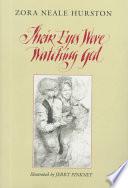
“She had waited all her life for something, and it had killed her when it found her.”
Source: Their Eyes Were Watching God

Their Eyes Were Watching God is a 1937 novel and by African-American writer Zora Neale Hurston. It is considered a classic of the Harlem Renaissance of the 1920s, and it is probably Hurston's best known work. The novel explores main character Janie Crawford's "ripening from a vibrant, but voiceless, teenage girl into a woman with her finger on the trigger of her own destiny".Set in central and southern Florida in the early 20th century, the novel was initially poorly received. Since the late 20th century, it has been regarded as influential to both African-American literature and women's literature. TIME included the novel in its 2005 list of the 100 best English-language novels published since 1923.
“She had waited all her life for something, and it had killed her when it found her.”
Source: Their Eyes Were Watching God
“… she starched and ironed her face, forming it into just what people wanted to see…”
Source: Their Eyes Were Watching God
“They seemed to be staring at the dark, but their eyes were watching God.”
Source: Their Eyes Were Watching God
“Some people could look at a mud puddle and see an ocean with ships.”
Source: Their Eyes Were Watching God
“Ships at a distance have every man's wish on board.”
Source: Their Eyes Were Watching God (1937), Ch. 1, p. 9.
“She had an inside and an outside now and suddenly she knew how not to mix them.”
Source: Their Eyes Were Watching God
Source: Their Eyes Were Watching God (1937)
Context: "Well, Ah see Mouth-Almighty is still sittin' in de same place. And Ah reckon they got me up in they mouth now.""Yes indeed. You know if you pass some people and don't speak tuh suit 'em dey got tuh go way back in yo' life and see whut you ever done. They know mo' 'bout yuh than you do yo' self. They done 'heard' 'bout you just what they hope done happened.""If God don't think no mo' 'bout 'em than Ah do, they's a lost ball in de high grass."
Janie and Phoeby, Ch. 1, p. 16.